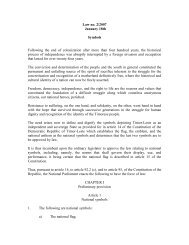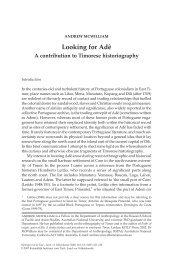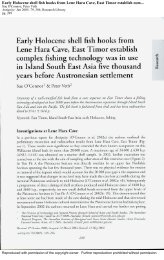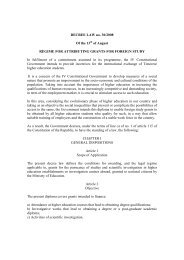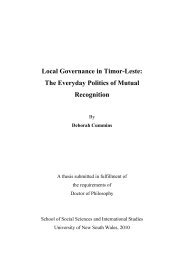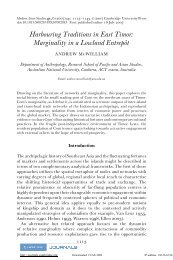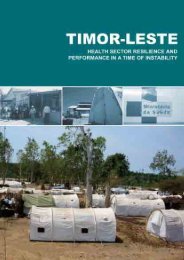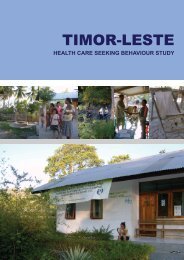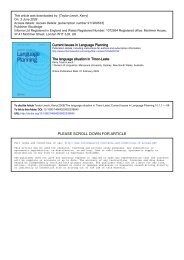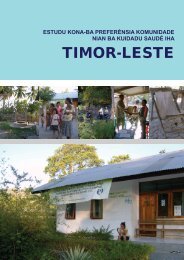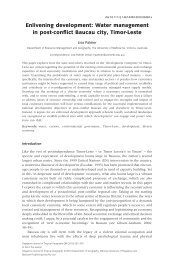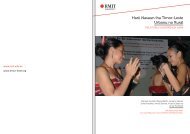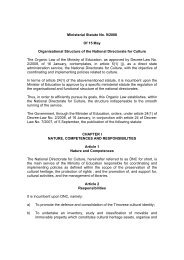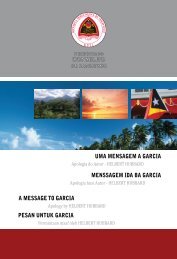The Naueti relationship terminology - Secretaria de Estado da Arte e ...
The Naueti relationship terminology - Secretaria de Estado da Arte e ...
The Naueti relationship terminology - Secretaria de Estado da Arte e ...
You also want an ePaper? Increase the reach of your titles
YUMPU automatically turns print PDFs into web optimized ePapers that Google loves.
242<br />
David Hicks<br />
man that inclu<strong>de</strong>s the father’s sister’s <strong>da</strong>ughter. In many instances the structure<br />
of the <strong>terminology</strong> and concomitant marriage rule converges with institutional<br />
arrangements ‘on the ground’, so that male ego’s <strong>de</strong>scent group contracts affinal<br />
alliances with specified <strong>de</strong>scent groups (‘wife-givers’) that provi<strong>de</strong> his own<br />
group with wives, and other – clearly distinguished – specified <strong>de</strong>scent groups<br />
(‘wife-takers’) that receive his own group’s female kin (for example, sisters, father’s<br />
sisters, and <strong>da</strong>ughters) as wives. <strong>The</strong> respective statuses of wife-giver and<br />
wife-taker are exclusive. Wife-giving <strong>de</strong>scent groups may not receive women<br />
from ego’s <strong>de</strong>scent group nor do ego’s wife-taking partners provi<strong>de</strong> his own<br />
<strong>de</strong>scent group with wives. In contrast, in a symmetric <strong>terminology</strong> of prescription<br />
(or ‘two-section’ system) both matrilateral cross-cousins and patrilateral<br />
cross-cousins are conjoined into a single category (for example, MBD = FZD)<br />
and the rule of marriage may permit marriage with either. However, in some<br />
instances, although a symmetric <strong>terminology</strong> is employed, there may still be a<br />
prohibition against marriage between male ego and his female patrilateral crosscousin,<br />
with the result that the same triadic structure of affinal alliances, that is,<br />
wife-giver/ego’s <strong>de</strong>scent group/wife-taker, that one finds with a <strong>terminology</strong> of<br />
asymmetric prescriptive alliance, is in force. <strong>The</strong> (symmetric) <strong>terminology</strong> and<br />
the (asymmetric) alliance system are thus disjunctive. This heterology recurs<br />
in several other combinations, for example, asymmetric alliance accompanied<br />
by a non-prescriptive <strong>terminology</strong> (Hicks 1987) or a <strong>terminology</strong> of asymmetric<br />
prescriptive alliance unaccompanied by asymmetric alliance (Barnes 1974).<br />
Instances of these and other combinations are well-displayed in eastern Indonesia,<br />
which, since F.A.E. van Wou<strong>de</strong>n published his Sociale structuurtypen in <strong>de</strong><br />
Groote Oost in 1935, has gained recognition as an area in which the changes are<br />
rung on a number of variations and combinations of <strong>terminology</strong> and alliance.<br />
In particular, East Timor (Figures 1 and 2), with approximately fifteen<br />
ethnolinguistic groups within a relatively small region, offers an unusually<br />
promising laboratory for the comparative study of these variations and combinations,<br />
for while asymmetric alliance is so prominent and pervasive a feature<br />
of the social organizations of almost all the populations of East Timor as to be<br />
consi<strong>de</strong>red virtually their <strong>de</strong>fining feature, we find it combined with all manner<br />
of nomenclatures. Although notable instances also occur on the islands of<br />
Sumba and Flores, as well as in the western half of Timor, in East Timor the<br />
presence of the barlaque (as the institution is wi<strong>de</strong>ly called) is so ubiquitous<br />
that to <strong>da</strong>te only in one small area of the country is it known not to be practised.<br />
Even after twenty-four years of occupation by the military forces of the<br />
From the perspective of female ego the prescriptions and proscriptions are the reverse, that is,<br />
marriage with a category of male that inclu<strong>de</strong>s father’s sister’s son being enjoined and marriage<br />
with a category of male that inclu<strong>de</strong>s mother’s brother’s son being forbid<strong>de</strong>n.<br />
In the Viqueque subdistrict in Viqueque district among certain Tetum-speaking communities<br />
(Hicks 2004).



